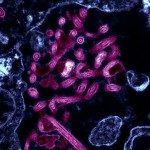Lien vers Pubmed [PMID] – 23623866
Vaccine 2013 Jun;31(27):2852-61
Neisseria meningitidis is responsible for the seasonal burden and recurrent epidemics of meningitis in an area of sub-Saharan Africa known as the meningitis belt. Historically, the majority of the cases in the meningitis belt are caused by serogroup A meningococci. Serogroup C meningococci were responsible for outbreaks in the meningitis belt in the 1980s, while serogroup W (formerly W-135) has emerged as a cause of epidemic meningitis since 2000. Serogroup X meningococci have previously been considered a rare cause of sporadic meningitis, but during 2006-2010, outbreaks of serogroup X meningitis occurred in Niger, Uganda, Kenya,Togo and Burkina Faso, the latter with at least 1300 cases of serogroup X meningitis among the 6732 reported annual cases. While serogroup X has not yet caused an epidemic wave of the scale of serogroup A in 1996-1997 or serogroup W in Burkina Faso during 2002, the existing reports suggest a similar seasonal hyperendemicity and capacity for localised epidemics. Serogroup X incidence appears to follow a pattern of highly localised clonal waves, and in affected districts, other meningococcal serogroups are usually absent from disease. Currently, no licensed vaccine is available against serogroup X meningococci. Following the introduction of a monovalent serogroup A conjugate vaccine (MenAfriVac(®)) in the meningitis belt and the upcoming introduction of pneumococcal conjugate vaccines, vaccine-based prevention of serogroup X may become a public health need. The serogroup X polysaccharide capsule is the most likely target for vaccine development, but recent data also indicate a potential role for protein-based vaccines. A multivalent vaccine, preferably formulated as a conjugate vaccine and covering at least serogroups A, W, and X is needed, and the efforts for vaccine development should be intensified.

